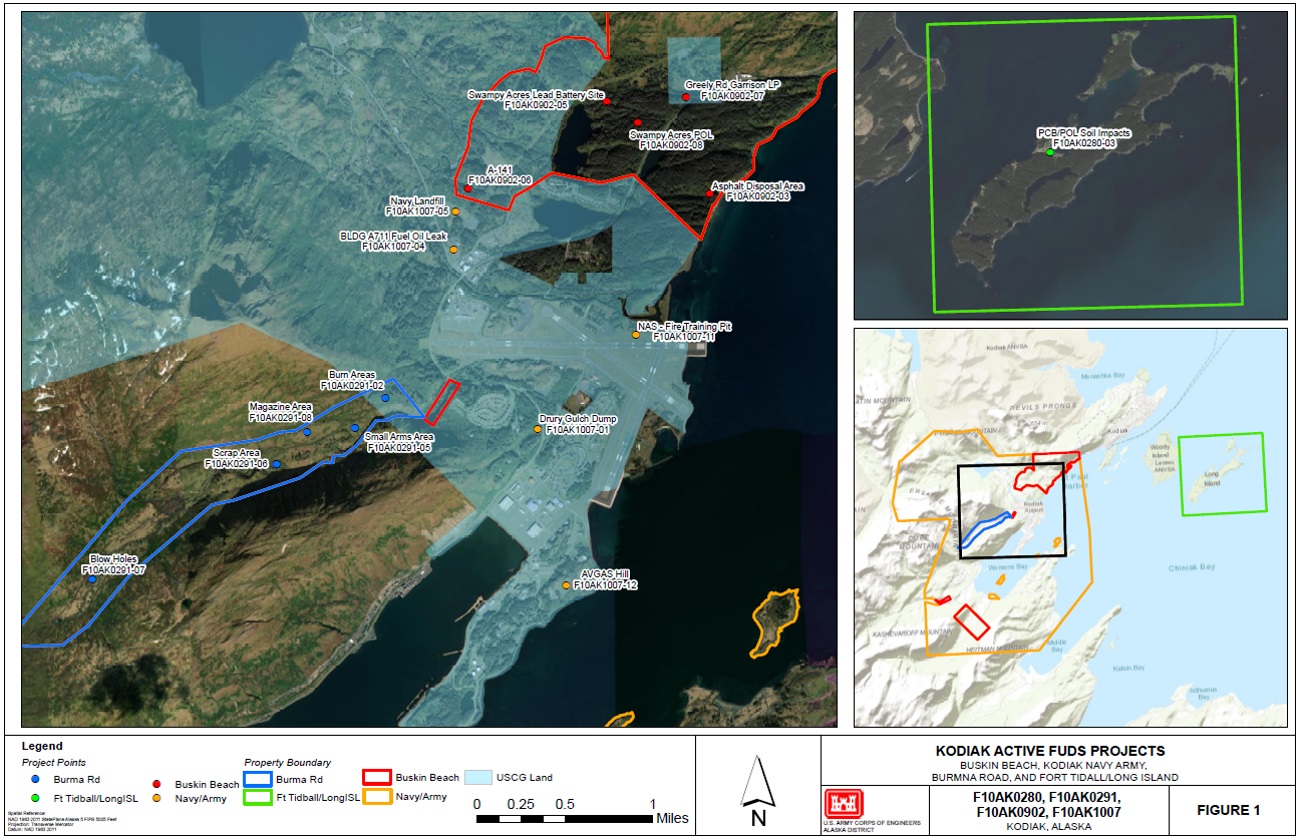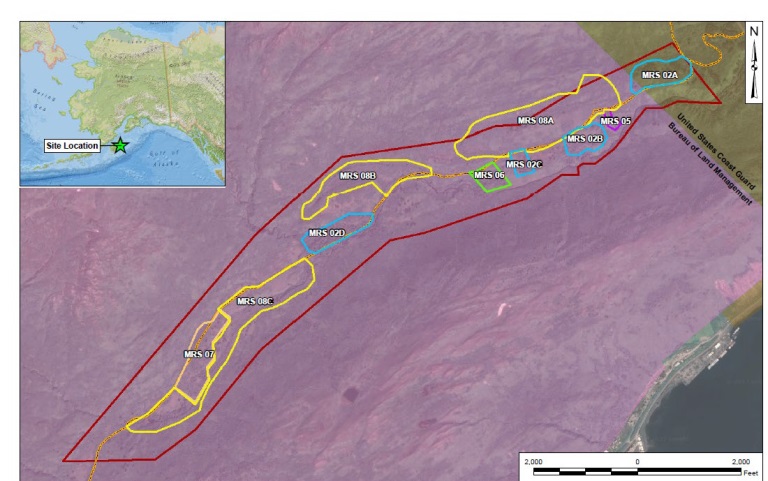
Kodiak Island, like many places in Alaska, has dozens of historic military installations in need of cleanup, known as Formerly Used Defense Sites or FUDS. There are 533 total across the state, 138 of them are in need of cleanup. The U.S. Army Corps of Engineers is in charge of remediation for multiple Kodiak-area sites but the process is slow-going, lasting decades in some cases.
One FUDS location on Kodiak Island is Burma Road, which was part of the old Kodiak Naval Station in 1939. It was used for ammunition storage, demolition of explosives and other military activities.
Burma Road, a 2.25-mile stretch containing five separate Munitions Response Sites, is now a popular Kodiak recreational area — and in the investigation phase of cleanup, which involves at least five years’ worth of work. That’s because previous surveys of the site discovered multiple burn areas, over 100 acres used for magazine storage and a small arms pit.
Joshua Barsis is the U.S. Army Corps of Engineers project manager for Burma Road along with other FUDS sites on Kodiak Island, and is responsible for the cleanup.
“(The Corps) found like a casing of a 750-pound bomb that had already been exploded. They found what we call munitions debris, or MD, which is flare casings, ammunition casings, bomb casings, various debris scattered from what may have been exploded at that time,” Barsis said.
Most of that munitions debris has been removed from Burma Road already, but it is suspected there are still more yet to be found.
The Army Corps uses a process under the Comprehensive Environmental Response Compensation and Liabilities Act, or CERCLA, to go about cleaning up other military branches’ munitions messes that date back before 1986, when each branch became responsible for its own cleanups.
Under CERCLA, three main stages apply to cleaning up all FUDS locations: an inspection of the site, an investigation phase and finally the cleanup.
There are four active sites encompassing 16 areas in need of cleanup on Kodiak Island, including Burma Road and Buskin Beach, Fort Tidball/Long Island and Kodiak Navy & Army Property. But, Barsis said, that’s the tip of the iceberg as more contaminated or munitions sites could potentially be added in the future.
“Burma Road has been around for a long time; we’ve known about it for a long time. But there are other sites on Kodiak that we have yet to look at that could be potential munitions sites,” he said. “And it’s going to take a lot of time and energy to start sorting through those.”

The Corps began planning the second phase of work, remedial investigation for Burma Road in 2021. Prior to that, the Alaska Department of Environmental Conservation along with the Corps had assessed and studied the site for decades going back to the late 1980s, and included a seven-year gap of no progress recorded between 2009 and 2016.
As part of the process, the Corps must hold public meetings, consult with relevant landowners and meet internally to get approval before moving forward into the third and final phase, cleanup.
Four other entities outside of the Corps, are involved in the Burma Road project – DEC, the federal Bureau of Land Management, the U.S. Coast Guard and Leisnoi Incorporated, an Alaska Native Village Corporation.
Jana Turvey is the president and chief executive officer of Leisnoi, which is the landowner of the property in question on Burma Road. She said she hopes the multi-year cleanup will result in a new chapter for the land.
“So that we can then potentially look at that land as part of our overall base for economic development, natural resources, and other things that will benefit our shareholder base going forward,” Turvey said.
According to the Corps of Engineers, Leisnoi is requesting the BLM transfer land ownership of Burma Road, through an open claim under the Alaska Native Claims Settlement Act of 1971. Turvey told KMXT she has no comment on that transfer.
The Corps of Engineers and its contractor, Colorado-based Ayuda Plexus Joint Venture, plan to start geophysical mapping at the Burma Road response sites this spring, into the summer and then again in the spring of 2025. Then the Corps will prepare a report for each area sometime after the spring of 2025.
If the contractors find some sort of unexploded ordinance or something potentially dangerous to the public at any time, according to Barsis, they will remove that threat on-site immediately.
Barsis said from that point, cleanup could be approved at any or all of the five Burma Road sites. The extent and timing of the work depends on funding from higher-ups at the Corps of Engineers.
“But there’s a chance that the remedy that is decided upon, which will be six or seven years from now, is so expensive that once again it goes onto the back shelf and it sits there until we can get funding to go finish it,” he said.
Barsis believes it is unlikely the cleanup won’t be funded all the way through to the end at Burma Road. He went on to say though that there is no such thing as a completely closed case when it comes to munitions sites. The Corps, in most cases, would continue to monitor and review the majority of munitions sites periodically, like every five years at Burma Road for example, for the foreseeable future.
The mapping and investigation work, which is taking place over the next year, is unlikely to disrupt public access according to the Corps.
Representatives from Kodiak nonprofit Island Trails Network were at a public meeting earlier this month on Feb. 15, hosted by the Corps of Engineers in Kodiak to outline the investigation work planned for Burma Road. ITN expressed concerns over locals’ trail access during the Corps process.
Barsis said a complete cleanup of Burma Road is likely still five or more years away.




